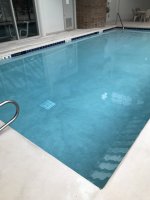- May 23, 2015
- 24,411
- Pool Size
- 16000
- Surface
- Plaster
- Chlorine
- Salt Water Generator
- SWG Type
- Pentair Intellichlor IC-60
Starting to question that myself.... especially if we are not on the same page about testing and maintenance. If the pool company and I were seeing eye to eye, then it might be a different story, but since you are telling me that the titration test is the more accurate test.... and we are getting readings that are quite far apart between the two tests.... then I may just bow out of this altogether unless they agree to use the titration test. I doubt they will.... takes a little more time.... and expect I will hear "we have always done it this way".
Question: So, if they are measuring bromine at 3-4 ppm using the color comparator test and I get 12-13 ppm with the titration test, is it even safe to go in the pool? The water looks good.... very clear.... but is it unsafe/ unhealthy if bromine is at 12? What are the potential harmful effects. Now I'm wondering if I even want to be in that pool.... or have my grandkids in there.
It’s hard to say what the exact breakdown is between active bromine and combined bromine (bromamines). Typically speaking, simple bromamines are not as irritating to a lot of people like chloramines are. They’re not totally benign either. But it’s not unlike any other communal swimming pool - you might come out smelling like chlorine or with red, irritated eyes but it isn’t going to kill you. And kids (grandkids) are notoriously tolerant of even the nastiest of swimming pool waters.
Their reported low values compared to your higher values is likely due to their test bleaching out if they are using a DPD test. You can pickup a cheap OTO (yellow) sanitizer test and see what result that gives as OTO is less prone to bleaching out. If the OTO shows a darker yellow/orange color, then the sanitizer is on the high side. You can’t really trust the OTO number/color scale much beyond that though as it is notoriously inaccurate. Clear is no sanitizer, light-straw yellow is low sanitizer, taxi cab yellow is moderate/high sanitizer and anything that approaches orange/brown is very high sanitizer. That’s about the best you can get from OTO.
You can’t have a rational discussion with pool service companies. They are going to manage a pool as they see fit to satisfy regulations and their profit/bottom-line. That pool is just a dollar-figure to them and they could care less about the water quality as long as the pool water is clear and no one in charge (aka, the property owner) is bothering them. As I said above, most people tolerate very low quality pool water well enough that they just attribute any ill-effects to it being a “swimming pool”. Most people are conditioned to expect swimming pools to be gross and don’t think much beyond that. TFP ruins that blissful ignorance by showing people that pool water can be quite easy to make both sanitary and enjoyable. This is why most TFP’ers will never step foot in a public pool or even a neighborhood pool. I, personally, can’t stand water parks or public pools any longer and force my wife to trudge around with the kids while I relax in a lounge chair answering questions about pools on TFP



